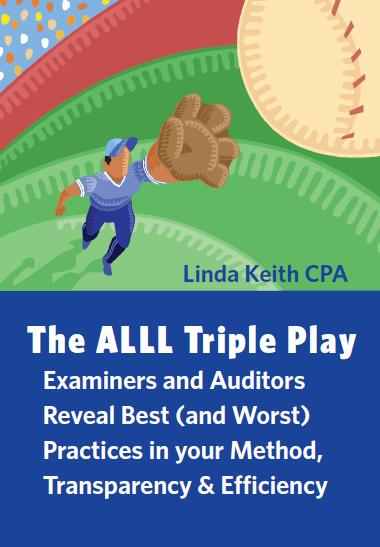Director question:
The Allowance for Loan and Lease Losses gets a lot of attention. What is appropriate for a director to understand?
Linda says:
When you read the guidance about a director’s responsibility for the ALLL, it can be downright scary!
Background
If you are feeling clueless as to the Allowance for Loan and Lease Losses (ALLL) check out these posts and archived answers and then come back:
- What does it all mean? Glossary of Bank Risk and Failure Terms
- What do you do with excess capitalization?
- The ALLL Time Warp: Why Getting it Done is Getting Harder
The examiners and auditors are concerned

In researching the book I am writing on “The ALLL Triple Play: Examiners and Auditors Reveal the Best (and Worst) Practices for Method, Transparency and Efficiency” it is clear to me that neither the examiners nor the auditors are completely happy with the practices they are seeing. In fact, they have serious concerns.
What worries the examiners and auditors probably should have your attention, too.
The short version
A director of a financial institution (FI) should have a grasp of the following:
- The allowance is a contra-asset (negative on the asset section) of the Balance Sheet and reduces the amount in loans receivable to the amount your financial institution management actually expects to collect.
- In riskier environments, the allowance needs to increase to provide more protection. And as things improve, it can drop.
- The allowance is increased by an expense called ‘Provision for Loan and Lease Losses’ or when recoveries of previously charged-off loans outpace new charge-offs.
- The allowance, at it’s very best, is a guess. Management needs to apply judgement and develop a range for the allowance. Then pick from within the range.
What should you ask?
As a director, it is your job to ask substantive questions of management about issues that impact safety and soundness of the financial institution and/or help you evaluate whether management is carrying out the strategic direction set forth by the board.
Observe whether the allowance has increased, decreased or stayed the same since the last report to the board. Then consider these questions:
- Why has the allowance moved in the direction it has (or not been adjusted at all)?
- In our last examination, did the regulators have concerns about the method, documentation or amount of the allowance?
- What about the outside auditors?
- Over the next year, do you expect the allowance to increase, decrease or stay about the same?
- Where are we in comparison to our peer group? If the difference is significant, what are the reasons?
- What else should I be asking to assure myself that we are handling this estimate properly?
Not in the rear-view mirror yet…
Those were the words of a Credit Union CFO about six months ago. I doubt he has changed his tune.
So you are very smart to pay attention to this accounting estimate that has such an impact.
What if management gets it wrong?
If the allowance is underfunded, the regulators may take action. You may have to raise capital in an unfavorable environment. And the examiners and auditors will question the rest of your financial statement presentation, and even management competence, more closely.
It is a judgement call, though. If management has given serious thought to the analysis and to their conclusions about which loans are impaired, what look-back period to use, what historical loss rates to use, and when those should be adjusted for the current environment…and they have documented this data and thinking well…they have a good chance of impressing rather than worrying the examiners and auditors.
